
Mascot, 15 Chapters, 1935. Starring Tom Mix, Charles Middleton, Joan Gale, Edward Hearn, Bob Kortman, Edmund Cobb, Max Wagner, Edward Earle, Jason Robards Sr., Jack Rockwell, and Tony Jr.
In 1912, a Texas Ranger is killed defending the Ravenhead Indians from land-grabbing ruffians, and his young son resolves to carry on in his stead; twenty-three years later, the boy has become Ranger captain Tom Morgan (Tom Mix), and finds himself called on to protect the Ravenheads from a modern gang of land thieves determined to drive them off their reservation. Zaroff (Charles Middleton), a respected local rancher and oil magnate, is the man behind this new land-grab; he’s discovered that the reservation land is rich in X-94, a very rare element that can be used to create explosive weaponry more powerful than anything the world has yet seen–and is determined to acquire the land, as a prelude to dominating the international armament market. However, to achieve this goal Zaroff must first put a stop to Tom Morgan’s investigations–a task which proves very difficult, since the daring and resourceful Morgan well deserves the sobriquet of The Miracle Rider, bestowed on him by his friends the Ravenheads.
Though Mascot Pictures’ boss Nat Levine managed to sign many well-known former “names” (including Harry Carey, Henry B. Walthall, Ben Turpin, and Rin Tin Tin) to appear in his serials, he pulled off his all-time biggest chapterplay casting coup when he persuaded famed screen cowboy Tom Mix–one of the most prominent stars of the silent era–to come out of retirement and play the title role in The Miracle Rider. Levine had to pay Mix a huge salary (ten thousand a week for four weeks) to bring him to Mascot; to make sure of a return on this investment, Levine had Rider produced as a fifteen-chapter serial instead of one of Mascot’s standard twelve-chapter outings–thus allowing him to get three additional chapter-rental fees from theaters; Rider was also given an unusually long opening episode (almost forty minutes in length) that was rented at a higher-than-usual price. These precautions probably weren’t necessary, since Rider–thanks in large part to the still-famous Mix name–ultimately earned a small fortune for Mascot, proving more profitable than any of the studio’s other serials.



Above: Shots from the trailer for Miracle Rider, giving an idea of how thoroughly Levine ballyhooed his signing of Mix.
The financially-motivated elongation of Rider doesn’t tax the serial’s writing team (Barney Sarecky, Wellyn Totman, Gerald Geraghty, and John Rathmell) as severely as one might expect (considering that many Mascot serials don’t have plot enough for twelve chapters, let alone fifteen). The first episode is ridiculously padded out, by means of a trio of repetitive and heavy-handed “historical” vignettes that follow an identical pattern (famous American historical figure tells thuggish trappers or hunters not to antagonize Indians, thugs do so anyway, stock footage battles from Last of the Mohicans and Fighting With Kit Carson ensue). However, the subsequent prologue scenes depicting the Ravenheads’ final surrender to the US Army, their acquisition of their reservation, and the death of Tom Morgan’s father work well, since they’re directly connected to the main plot and provide a good dramatic background for it.
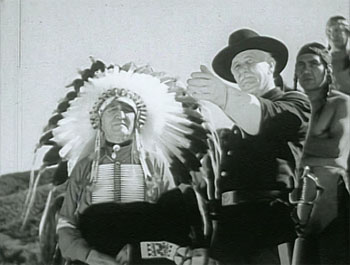

Above left: A cavalry officer (Lafe McKee) promises Last Elk (Chief Standing Bear) that the surrounding land will belong to his tribe forever. Above right: The dying Sam Morgan (Pat O’Malley) urges his son to follow in his law-enforcing footsteps and protect the Ravenheads.
Said main plot is spun out surprisingly well throughout an unprecedented (for Mascot) number of chapters; like practically all fifteen-episode serials, Rider could easily have been streamlined into a twelve-episode serial, but a series of strategically-placed plot developments keep the storyline from ever seeming as repetitious as those of many other chapterplays of similar length. The early episodes center mostly around the “Firebird,” a remote-controlled “glider” that emits a high-pitched wail and is used by Zaroff to terrorize the Ravenheads; this intriguing gadget is destroyed (far too early) in Chapter Two, but Morgan’s search for its wreckage and the villains’ efforts to prevent him from locating it keep the plot rolling all the way through Chapter Four. The next three episodes revolve around Zaroff’s attempt to pin his crimes on crooked storekeeper Emil Janss, his efforts to rescue a captive henchman, and his scapegoating of his own cohort Stelter–events which wind up alerting Janss to Zaroff’s schemes and cause him to force his way into Zaroff’s organization as a partner in Chapter Eight.
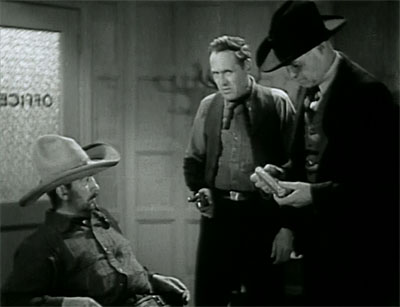
Above: Janss (Edward Hearn, far right) realizes the importance of the tube of X-94 in his hands, as his henchman (George Chesebro) holds a gun on one of Zaroff’s men (Charles King).
Chapter Nine, in which the villains frame Ravenhead tribesman Featherfoot for theft in order to further their schemes, sets the serial snowballing directly towards its conclusion; in the course of destroying this frame-up, Morgan strikes an investigative trail that leads him first to Longboat (Zaroff’s agent on the Ravenhead reservation), then to Janss, and then to the discovery of the X-94 cache and the unmasking of Zaroff himself. The protracted manhunts arising from each of these exposures (and from the earlier tug-of-war over captured henchman Sewell and the betrayal of Stelter) do come off as somewhat redundant, but the way in which the assorted malefactors are unmasked in order of importance gives the narrative a sense of forward momentum nonetheless. The absence of the long flashbacks used to kill time in so many other Mascot outings also helps the plot maintain its momentum; the serial’s only recap scene is a very brief one that has a direct bearing on the current action.

Above: Morgan (Tom Mix, left) and a fellow Ranger (Jack Rockwell) are entering the villains’ cave hideout in search of the fugitive Janss–and are soon to discover the secret of X-94 there.
Rider’s action scenes are well-staged by directors B. Reeves Eason and Armand Schaefer, and well-photographed by cinematographers William Nobles and Ernest Miller; as in other Mascot serials, the shots that depict the many horseback chase sequences are strikingly scenic and well-composed, and substantially add to the sequences’ entertainment value. The Chapter Two chase is especially excellent, as are the hero’s cross-country gallop to head off the villains’ car in Chapter Five and the chases in Chapters Eight and Nine; the latter sequence has two stuntmen (doubling heroine Joan Gale and supporting player Nick Thompson) impressively changing horses in mid-chase. The Chapter One sequence which has the hero pursuing the villains’ truck on horseback, transferring to its cab, and grappling with the driver as the truck careens wildly along a mountain road is another highlight; the climactic horseback pursuit of Zaroff’s getaway car is very good too. Several expert equestrian stuntmen–Yakima Canutt, Tracy Layne, Ken Cooper, Cliff Lyons, Jay Wilsey–worked on these and other scenes; it’s hard to determine which of them pulled off the excellent horse-switching bit, but it’s Lyons who doubles star Tom Mix throughout much of the serial.




Above: Our hero makes a transfer from horse to truck (top left), gallops down a slope (top right), and takes a fence-jumping shortcut (bottom right) to head off fleeing villains (bottom left) who are going around the fence the long way.
Canutt and Lyons, both of whom were also adept at fight scenes, are probably responsible for the fairly infrequent but uniformly solid rough-and-tumble brawls scattered throughout Rider; the best of these are the short, prop-scattering fight in the storeroom in Chapter Six and the longer fight in Zaroff’s shed in Chapter Ten. Other standout action sequences include the terrific Chapter Three sequence in which Mix eludes and neatly picks off a group of heavies with a variety of ambush techniques, the nicely-shot gun battle in the cave hideout in Chapters Three and Four, the lengthy game of cat-and-mouse played between hero and villains in Janss’s store in Chapters Eleven and Twelve, and the last-chapter shootout at Zaroff’s ranch. The above-mentioned cave, which figures in more than one action scene, is partially portrayed by one of the caverns in Bronson Canyon, while most of the rest of the serial’s action takes place on the picturesque slopes of Iverson’s Ranch.
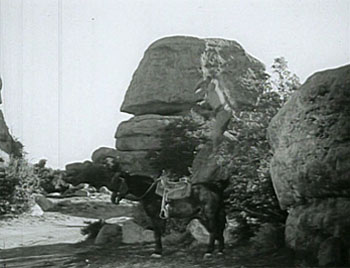


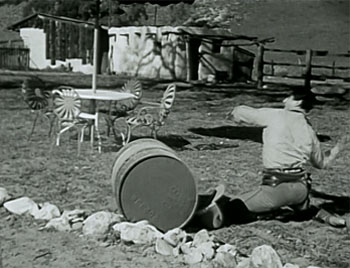
Above, top left: Cliff Lyons (doubling Tom Mix) leaps from a boulder onto his horse as he dodges villains in Chapter Three. Top right: A striking shot of Mix from the cave shootout sequence. Bottom left: Boxs and barrels go tumbling in the background as Lyons charges Tom London (or his double) during the Chapter Six storeroom fight. Bottom right: Mix, taking precarious cover behind an oil-drum, tosses tear-gas bombs at the villains during the last-chapter ranch battle.
Rider’s first two cliffhangers, a truck explosion caused by an X-94-powered bullet and the crash of the Firebird glider, are first-rate–particularly the latter one, which is enhanced by Howard Lydecker’s effects work; the glider miniature used will be instantly recognizable to Republic buffs as the direct ancestor of the Falcon Plane in King of the Mounties. However, many of the other chapters merely conclude with the hero apparently being shot; the writers do come up with many ways of varying this overused situation (Mix is shot off a cave ledge, shot off his horse, shot by a rigged rifle as he opens a door, shot while climbing down a cliff, shot while hiding behind a storeroom crate, shot off his horse again), but the shooting cliffhangers are far too frequently resolved by blatant alterations of last week’s action in the next episode’s escape scenes; similar cheating is used to “resolve” the Chapter Six stampede cliffhanger. The resolution of the storeroom shooting is a fair (and creative) one, at least; the Chapter Eleven shed explosion and the “situational” Chapter Fourteen cliffhanger–which consists of ominous close-ups of the villains’ gun barrels and a grim proclamation by Zaroff (“Morgan, you’re done”) are also quite good (the success of the latter scene is largely owing to actor Charles Middleton’s talent for sounding menacing).


Above left: The Firebird glides towards destruction, with Mix supposedly aboard, at the end of Chapter Two. Above right: Mix (Cliff Lyons doubling) is seconds away from being plugged as he rappels down that cliff at the end of Chapter Seven.
Tom Mix, Rider’s star attraction, was well past his leading-man prime when the serial was made, but his performance is still strong enough to give a good idea of the screen presence he possessed during his heyday. His husky, rough-sounding drawl, caused by a throat injury that also gave him trouble with dialogue, was supposedly one of the reasons for his retirement during the early-talkie era–but, while he does stumble over his lines on occasion, his voice actually sounds quite well-suited to a Western hero, particularly for one who’s supposed to be a seasoned Ranger commander. His sternly commanding manner also fits his lawman character well, although he leavens this authoritativeness with some lighter touches more than once–lapsing from gravity into boyish mischievousness during the pie-snatching bit in Chapter One, flashing an infectiously cheerful grin after outsmarting the villains in Chapter Three, and handling occasional quips (like his remark at the end of the Chapter Three scene or his wisecracks to Zaroff in the final chapter) with an appealing air of wry humor. Though fifty-five years old, Mix also manages to look physically convincing as an action hero, and can be seen doing some of his own horseback work (he was still active in the Wild West show business at this time); Lyons’ extensive doubling for him (mentioned above) was not due so much to the star’s physical limitations as it was to his big salary; simultaneously filming dialogue scenes with Mix and action scenes with Lyons allowed Levine to reduce the hours Mix spent working on the serial.
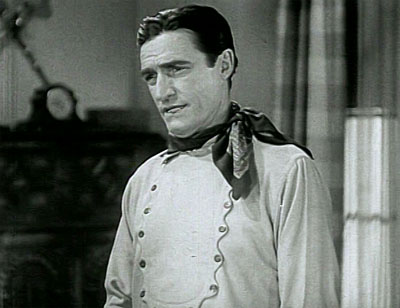
Above: Tom Mix explains his plans.
Charles Middleton, making his sound-serial debut, is in top form as the ruthless Zaroff; his adoption of a suavely genial man-of-the-world manner in his interactions with Mix and other respectable citizens is both amusing and convincing, while his demonically cunning smile when he outlines plans, his equally devilish glare when he prepares to exterminate his enemies, and his recurring evil chuckle (“Heh!”) all foreshadow his later signature performance as Ming the Merciless. He even manages to make his incessantly repeated line about how a monopoly on X-94 will make him “the most powerful man in the world” sound intimidatingly and intensely sinister every single time he delivers it; his sarcastic exultance during his last-chapter confrontation with Mix is also something to see.

Above: Charles Middleton contacts one of his followers.
As Ruth, the daughter of murdered Ravenhead chieftain Black Wing, attractive leading lady Joan Gale remains on the sidelines much of the time, but effectively displays quiet admiration for Mix, urgent concern for the fate of her people, and a motherly combination of firm but gentle authority in her interactions with her tribal followers. She also conveys quick-thinking alertness in the scenes in which she does take center stage–as when she rescues Featherfoot or purloins a carload of X-94 from the villains’ cave hideout. Though obviously not a genuine Indian, her dark braided hair, somewhat prominent nose, and almond-shaped eyes (a bit reminiscent of Myrna Loy’s) help her to look a little less incongruous in the role than some actresses would have; she’s also (thankfully) not saddled with broken-English dialogue, and is allowed to speak in complete sentences.
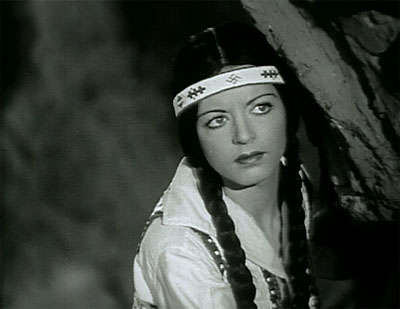
Above: Joan Gale keeps an eye on the villains.
Edward Hearn, most frequently a put-upon good man in Mascot’s serials, here portrays the definitely put-upon but completely villainous storekeeper Janss (who plots to drive off the Indians even before allying with Zaroff, as part of a plan to force the government to purchase new reservation land from him). As in his sympathetic roles, Hearn plays his part somewhat hammily but very energetically–blustering pompously and aggressively when he’s accused of crimes (or when accusing someone else of wrongdoing), and registering nervous near-panic when he’s forced to go on the run; he also shows a somewhat more uncharacteristic self-assured coolness when he’s trying to blackmail Middleton into letting him join his organization. As Stelter, Janss’s clerk and Zaroff’s spy, the unfailingly entertaining Ernie Adams has some good shifty moments, a funny comic bit (his exasperated reaction to the heroine’s shopping-based stall tactics), and a memorable final scene in which he flies into an unexpected rage and storms into Zaroff’s lair after learning that his boss plans to make him a fall guy.
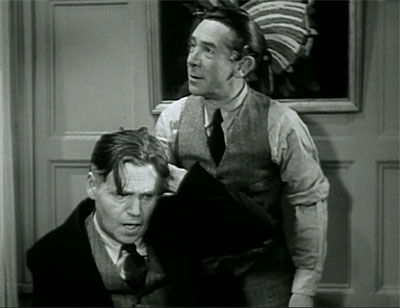
Above: Edward Hearn (seated) and Ernie Adams try to answer some difficult questions.
Bob Kortman does an excellent job as the renegade Ravenhead Longboat, who aspires to the tribe’s chieftainship and allies himself with Zaroff in his pursuit of this goal; though the character isn’t nearly as murderous as Kortman’s Magua in Last of the Mohicans, Kortman plays the part in the same snarling, bitter, and frightening fashion–particularly when trying to scare his fellow Indians with talk of the Firebird or when threatening the Indian Agent in Chapter Ten. The agent is well played by Edward Earle, who combines sober dignity with worried thoughtfulness and comes off as more dedicated to his duties and responsibilities than more complacent-acting serial official. As Chief Black Wing, Robert Frazer is given prominent billing but very little screen time; he makes the most of his part–delivering his dialogue in his characteristically booming-voiced and gravely theatrical style–before getting killed off towards the end of the first chapter.


Above left: Bob Kortman. Above right: Edward Earle (seated) congratulates Robert Frazer (center) and Nick Thompson on their tribe’s success in saving enough money to purchase new farming equipment.
As Zaroff’s office-bound aide Carlton, Jason Robards Sr. makes a great foil for Charles Middleton, his smugly down-to-earth bearing and his flatly calm voice contrasting ideally with the grimly impassioned and resonant-sounding Middleton. Former silent star Niles Welch plays Zaroff’s scientific assistant Metzger–spending most of his scant screen time tinkering with impressive-looking props in the villains’ secret laboratory, but occasionally getting to excitedly preside over tests of inventions. Reliable veteran Edmund Cobb heads up Zaroff’s henchman pack, snapping out orders and sardonic remarks with his usual no-nonsense gruffness; next in order of henching importance is the smirking and swaggering Max Wagner (also seen in Mascot’s The Lost Jungle).
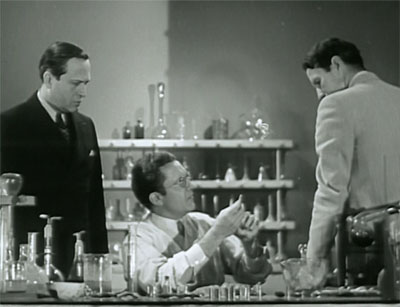
Above: Niles Welch (center) shows an X-94-packed bullet to Charles Middleton (right) as Jason Robards Sr. watches.
Cobb and Wagner are supported for most of the serial by Cobb’s fellow-veterans Charles King and Tom London and by then-newcomer Stanley Price. All three players take part in a lot of active villainy, and also get good chances to display their individual screen personalities at various points–King when he phlegmatically but slyly plots a double-cross with Price, London (who plays the previously-referenced Sewell) when he nervously but craftily tells lies for the benefit of Tom Mix after being arrested, and Price when he trembles over the prospect of being charged with Black Wing’s murder and when he grins crazily over the temporary success of King’s double-cross scheme. As Janss’s chief henchman, George Chesebro has less screen time than any of the members of the Zaroff gang, but is given a moment to shine when he noisily agrees to squeal on his boss; Slim Whitaker is also one of Janss’s thugs, while Forrest Taylor appears briefly as another Zaroff henchman.

Above, left to right: Max Wagner, Stanley Price, Charles King, Edmund Cobb, and Tom London.
Jack Rockwell is likably rugged and genial as Tom Mix’s principal Ranger assistant; as another Ranger, Hal Taliaferro stays mostly in the background but has a few good moments–like his reaction to doctor Henry Hall’s long-winded diagnosis in Chapter Nine. Mix’s horse Tony Jr. (the offspring of the famous Tony that Mix rode in silent days) lends significant and super-equine aid to the hero in several scenes, even tapping his hoof to warn of a jailbreak he’s witnessed and pressing a car horn to distract some villains. Nick Thompson, a frequent portrayer of serial Indians, is amiable and amusing (in a subdued way) as the sleepily easygoing and frequently befuddled Featherfoot, but also is able to convincingly drop his comic manner for a dramatic confrontation with Bob Kortman.

Above: Tony Jr. arrives at the Ranger-station door to warn Jack Rockwell (left) and Hal Taliaferro of danger threatening Tom Mix.
Stuntman and former B-western star Jay Wilsey pops up briefly as a grave Daniel Boone in one of the prologue segments, while Bud Geary has fun in another segment as a canny and affable Davy Crockett. Tex Cooper, whose career as a Buffalo Bill Cody impersonator extended back to a stint with Cody’s own Wild West show, appears as–who else?–Buffalo Bill; Richard Alexander is the surly buffalo hunter that Cody vainly orders not to poach on Indian land, while Dick Curtis (abetted by Frank Ellis) similarly misbehaves in the Davy Crockett segment. Chief John Big Tree is a venerable Indian chief knifed by Curtis, and Chief Standing Bear and Lafe McKee share a good scene as (respectively) the regretful last war-chief of the Ravenheads and the respectful cavalry officer he surrenders to. Artie Ortego has a small recurring role as one of the modern-day Ravenheads, and Yakima Canutt has a brief speaking bit as another. Pat O’Malley is the hero’s father in the last of the prologue scenes, while Hank Bell (unrecognizable at first without his usual moustache) and Roger Williams are two of the land-grabbers who cause his death; the young actor who plays Mix’s character as a boy is not familiar.
Though undeniably overlong and marred by several cliffhanger cheats, The Miracle Rider has so much going for it–well-done action scenes, pleasing and nicely-photographed locations, a plot that’s well-structured overall, a strong hero, a terrific villain, and a once-in-a-lifetime collection of the serial genre’s great supporting heavies–that it’s fully as successful in providing entertainment value as it was in filling Nat Levine’s financial coffers. Many buffs rank it as the greatest of all Mascot’s serials, and it’s definitely one of the top contenders for that title.
Acknowledgements: My thanks to the Old Corral’s page on Miracle Rider (part of their Tom Mix section) and to message-board posts by Ed Hulse on the Continued Next Week forum at the In The Balcony site, both of which provided me with information about Mix’s deal with Levine and explained the reasons behind the serial’s king-sized first chapter and its overall fifteen-chapter length; the Old Corral page also provides a tally of the money (about a million dollars’ worth) raked in by Rider.

One of my favorites. I found little to fault. Though up in years, I felt Mix handled his leading role well ,followed by the supporting cast. For those who don’t have a DVD of the serial, I recommend VCI . Four stars.
****1/2 out of ***** My favorite Mascot. Mix was a terrific lead despite his years. The supporting cast was loaded with great character actors from Middleton on down. There was plenty of action, and the writing was solid. Motivations were credible and the plot flowed smoothly toward the climax. Tom Morgan was well etched as an on-top-of-it law officer. The only weakness was the resolutions of a few cliffhangers, but that didn’t hurt too much for me. The doubling for Mix didn’t seem nearly as extensive as some seem to have it. Yes, he wasn’t doing those running jump mounts, but he seemed to be the guy riding around and crawling down trees and up cliffs and hopping over fences, and it was obviously Mix doing a lot of the fighting in the fight scenes.
I liked the serial as well, but though I wouldn’t deny that the opening chapter may be long on “history lessons” for the partial purpose of padding, I think the fictionalized histories are also there to back up the theme of white-red relations. (Hmm, “theme” and “serial”– two words that almost never go together!)
You might find interesting my thoughts on RIDER’s first chapter, at the end of this review-post:
http://nummtheory.blogspot.com/2015/02/the-miracle-rider-1935.html
I definitely agree that the “historical” segments are partly intended to underscore the “protection-of-Indian-land” theme; I just think they’re unnecessary, and almost comical in their name-dropping. However, I suppose they were as good a way as any to pad out the first chapter, once one accepts that Levine was bound and determined to make it forty minutes long. Up to a point, I also agree with you that the prologue sequence presents an idealized and sanitized version of the westward expansion–by trying to make it seem as all Indian wars were caused by handfuls of greedy thugs and were not (Heaven forbid!) irrevocable conflicts arising from Indians and settlers’ irreconcilable cultures. However, I don’t watch serials for historical accuracy, but for entertainment–and, padding and all, Miracle Rider still ranks very high on the entertainment scale for me.
While the serial starts off rather slowly, once Mix appears the pace speeds up considerably and the film maintains a consistent level of action. The criticism of Mix’s performance and his alleged voice problems are pure nonsense. He possesses a fine baritone voice perfect for a western hero and his commanding screen presence dominates the entire production. Despite his age, he still cuts a fine figure, especially in the action scenes and when he is astride Tony Jr. The film is well stocked with good actors and an interesting story. While Mix may have been past his prime, he still displays the charisma of a great star, he is the whole show here, which makes The Miracle Rider so enjoyable.
Another entertaining serial from Mascot. The plot has many interesting elements, the action scenes are generally well staged, and there’s a terrific cast of villains. On the downside, it runs on longer than the narrative can sustain, has too many cliffhanger cheats throughout, and I thought the “superstitious Indians” angle at the beginning was overplayed, especially considering the story was set in the modern era. Despite his age, Tom Mix was effective and energetic in the lead role, although his silent-era acting style did come across as somewhat dated by this time. Charles Middleton and Edward Hearn made for a great pair of antagonists as the main bad guys. I had to laugh when Stelter (the Ernie Adams’ character) is identified over the police teletype as being “age 33”. Ernie must have really been flattered! Overall, the serial is well made and generally fun to watch. It’s not my favorite among the Mascot productions, but it’s still very much worth viewing.
Does anyone know the ranch that served as Charles Middleton’s ranch in The Miracle Rider (1935)?